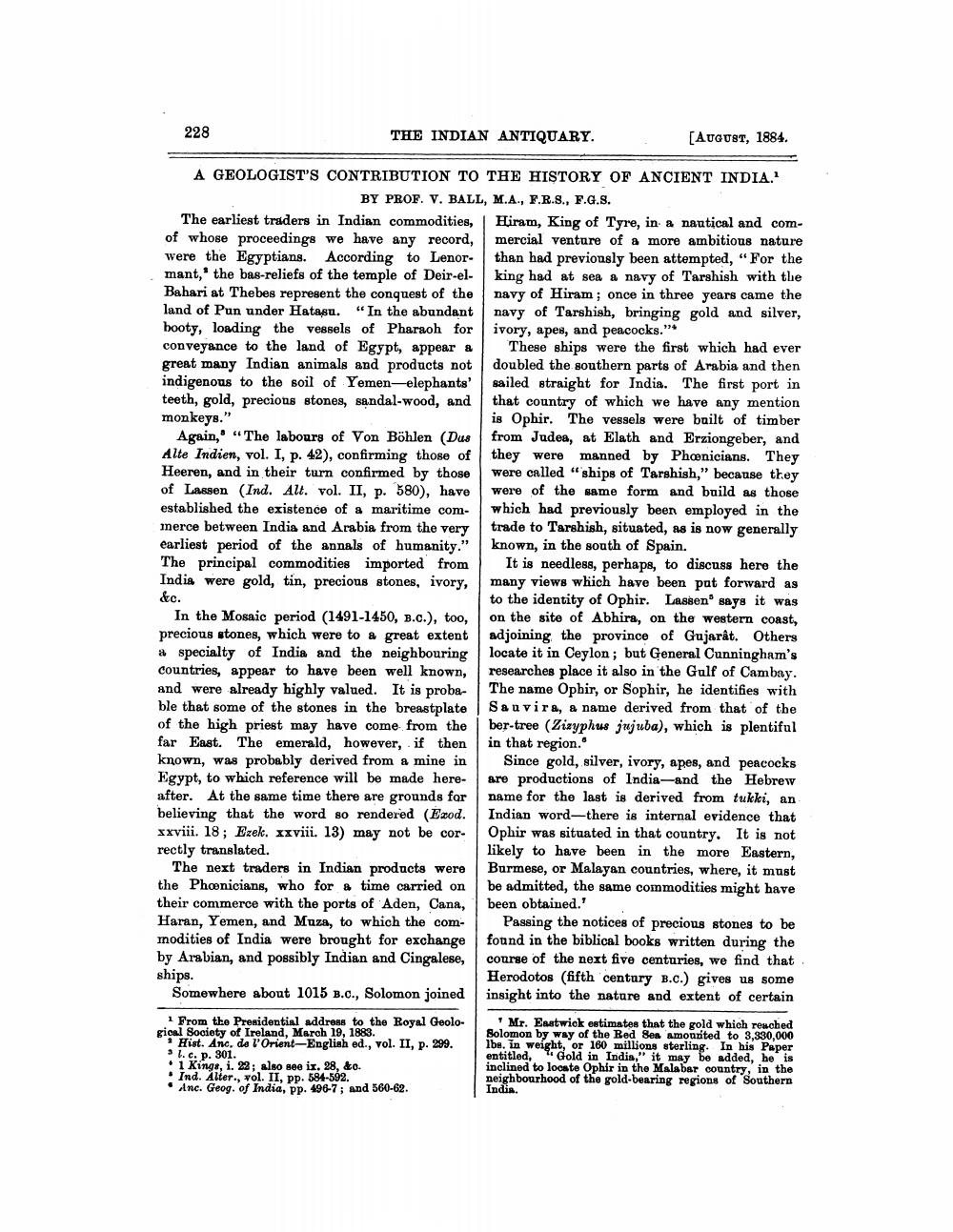________________
228
THE INDIAN ANTIQUARY.
[August, 1884.
A GEOLOGIST'S CONTRIBUTION TO THE HISTORY OF ANCIENT INDIA.
BY PROF. V. BALL, M.A., F.R.S., F.G.S. The earliest traders in Indian commodities, Hiram, King of Tyre, in a nautical and comof whose proceedings we have any record, mercial venture of a more ambitious nature were the Egyptians. According to Lenor- than had previously been attempted, “For the mant,' the bas-reliefs of the temple of Deir-el- king had at sea a navy of Tarshish with the Bahari at Thebes represent the conquest of the | navy of Hiram ; once in three years came the land of Pun under Hatasu. “In the abundant navy of Tarshish, bringing gold and silver, booty, loading the vessels of Pharaoh for ivory, apes, and peacocks." conveyance to the land of Egypt, appear & These ships were the first which had ever great many Indian animals and products not doubled the southern parts of Arabia and then indigenous to the soil of Yemen-elephants' sailed straight for India. The first port in teeth, gold, precious stones, sandal-wood, and that country of which we have any mention monkeys."
is Ophir. The vessels were built of timber Again, "The labours of Von Böhlen (Dus from Judea, at Elath and Erziongeber, and Alte Indien, vol. I, p. 42), confirming those of they were manned by Phænicians. They Heeren, and in their turn confirmed by those were called "ships of Tarshish," because they of Lassen (Ind. Alt. vol. II, p. 580), have were of the same form and build as those established the existence of a maritime com- which had previously been employed in the merce between India and Arabia from the very trade to Tarshish, situated, as is now generally earliest period of the annals of humanity." known, in the south of Spain. The principal commodities imported from It is needless, perhaps, to discuss here the India were gold, tin, precious stones, ivory, many views which have been put forward as &c.
to the identity of Ophir. Lassen says it was In the Mosaic period (1491-1450, B.c.), too, on the site of Abhira, on the western coast, precious stones, which were to a great extent adjoining the province of Gujarât. Others # specialty of India and the neighbouring locate it in Ceylon; but General Cunningham's countries, appear to have been well known, researches place it also in the Gulf of Cambay. and were already highly valued. It is proba- The name Ophir, or Sophir, he identifies with ble that some of the stones in the breastplate Sauvira, a name derived from that of the of the high priest may have come from the ber-tree (Zisyphus jujuba), which is plentiful far East. The emerald, however, if then in that region. known, was probably derived from a mine in Since gold, silver, ivory, apes, and peacocks Egypt, to which reference will be made here- are productions of India-and the Hebrew after. At the same time there are grounds for name for the last is derived from tukki, an believing that the word so rendered (Exod. Indian word-there is internal evidence that xxviii. 18; Ezek. xxviii. 13) may not be cor- Ophir was situated in that country. It is not rectly translated.
likely to have been in the more Eastern, The next traders in Indian products were Burmese, or Malayan countries, where, it must the Phoenicians, who for a time carried on be admitted, the same commodities might have their commerce with the ports of Aden, Cana, been obtained.' Haran, Yemen, and Muza, to which the com- Passing the notices of precious stones to be inodities of India were brought for exchange found in the biblical books written during the by Arabian, and possibly Indian and Cingalese, course of the next five centuries, we find that ships.
Herodotos (fifth century B.C.) gives us some Somewhere about 1015 B.C., Solomon joined insight into the nature and extent of certain 1 From the Presidential address to the Royal Geolo- Mr. Batwiok estimates that the gold which reached gioal Society of Ireland, March 19, 1883.
Solomon by way of the Red Sea amounted to 3,330,000 • Hist. Anc, de l'Orient-English ed., vol. II, p. 299. lbe, in weight, or 180 millions sterling. In his Paper 3 l. c. p. 301.
entitled, Gold in Indis," it may be added, he is • 1 Kings, i. 22: also see is. 28, &o.
inclined to locate Ophir in the Malabar country, in the . Ind. Alter., vol. II, pp. 584-592.
neighbourhood of the gold-bearing regions of Southern Anc. Geog. of India, pp. 496-7; and 560-62
India.




